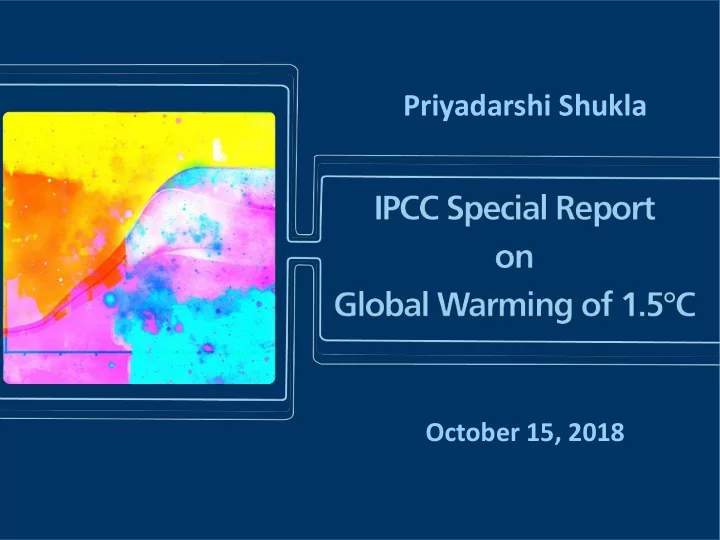

Priyadarshi Shukla October 15, 2018
Emission Pathways and System Transitions Consistent with 1.5°C Global Warming 8
Greenhouse gas emissions pathways To limit warming to 1.5°C, CO 2 emissions • fall by about 45% by 2030 (from 2010 levels) Compared to 20% for 2°C To limit warming to 1.5°C, CO 2 emissions • would need to reach ‘net zero’ around 2050 Compared to around 2075 for 2°C Reducing non-CO 2 emissions would have • direct and immediate health benefits Source: C1 SPM Gerhard Zwerger-Schoner / Aurora Photos 9
Carbon Budget (GtCO2) Using global mean surface temperature (GMST) • methodology, the remaining carbon budget is 770 Gt CO 2 for a 50% probability of limiting warming to 1.5 C and 570 Gt CO 2 for a 66% probability The remaining carbon budget is being depleted by • current emissions of 42+3 Gt CO 2 per year. Additional carbon release from future permafrost • thawing and methane release from wetlands would reduce budgets by up to 100 Gt CO 2 Source: C1.3 SPM Peter Essick / Aurora Photos 10
SPM3a & SPM3b
SPM3a: Global emissions pathway characteristics Pathways: - limiting warming to 1.5°C with no or limited (less than 0.1°C) overshoot
SPM3a: Global emissions pathway characteristics Pathways: - limiting warming to 1.5°C with no or limited (less than 0.1°C) overshoot - with high overshoot (at least 0.1°C and larger)
SPM3a: Global emissions pathway characteristics Pathways: - limiting warming to 1.5°C with no or limited (less than 0.1°C) overshoot - with high overshoot (at least 0.1°C and larger)
SPM3a: Global emissions pathway characteristics
SPM3a: Global emissions pathway characteristics
SPM3b: Characteristics of four illustrative pathways Breakdown of global net anthropogenic CO 2 emissions Three contributions to global net anthropogenic CO 2 emissions • CO 2 emissions from fossil fuel and industry • Net CO 2 emissions from agriculture, forestry, and other land use (AFOLU) • CO 2 removal by bioenergy with carbon capture and storage (BECCS)
SPM3b: Characteristics of four illustrative pathways Breakdown of global net anthropogenic CO 2 emissions Four carefully selected illustrative pathways:
SPM3b: Characteristics of four illustrative pathways Set of pathway y charact acteris eristics tics, caref eful ully ly select cted ed to illus lustrate: : • Climate outcome and emissions implications • Energy system transition • Carbon dioxide removal (CDR) and land implications
SPM3b: Characteristics of four illustrative pathways
Feasibility Indicators for ‘1.5 ° C’ Consistent Pathwa hways ys Characteristics Indicators to Assess Feasibility of Mitigation Options Cost-effectiveness; Absence of distributional Economic Employment & productivity, enhancement potential Technical scalability; Maturity; Simplicity; Absence Technological of risk Political acceptability; Legal & administrative Institutional feasibility Institutional capacity; Transparency & accountability potential Social co-benefits (health, education); Public Socio-cultural acceptance Social & regional inclusiveness; Intergenerational equity Human capabilities Reduction of air pollution; Reduction of toxic waste Environmental/ Source: Table 4.10 Reduction of water use; Improved biodiversity Ecological Physical feasibility (physical potentials); Limited use Geophysical of land; Limited use of scarce (geo)physical resources; Global spread
Ch Change nges s at Un Unpre rece cedented dented Sc Scale le Limiting warming to 1.5°C would require • changes on an unprecedented scale Rapid and far-reaching transitions all sectors A range of technologies Behavioural changes Increased investment in low carbon options Source ce: : C3 SPM
Ali lign gnin ing g Ambiti ition on and Act ctio ions National pledges are not enough to limit • warming to 1.5°C (D1 SPM) Progress in renewables would need to be • mirrored in other sectors. The solutions required to limit warming to • 1.5ºC are available. What is required is to speed and scale up implementation. These solutions confer synergies with • sustainable development
Questions? Q&A
Recommend
More recommend